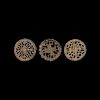Western Asiatic Large Stamp Seal Collection
Lot 340
About Seller
TimeLine Auctions Limited
The Court House, 363 Main Road
Harwick, Essex CO12 4DN
United Kingdom
Estimate:
GBP£800 - GBP£1,000
$1,081.08 - $1,351.35
Absentee vs Live bid
Two ways to bid:
- Leave a max absentee bid and the platform will bid on your behalf up to your maximum bid during the live auction.
- Bid live during the auction and your bids will be submitted real-time to the auctioneer.
Bid Increments
| Price | Bid Increment |
|---|---|
| GBP£0 | GBP£5 |
| GBP£100 | GBP£10 |
| GBP£200 | GBP£20 |
| GBP£500 | GBP£50 |
| GBP£1,000 | GBP£100 |
| GBP£2,000 | GBP£200 |
| GBP£5,000 | GBP£500 |
| GBP£10,000 | GBP£1,000 |
| GBP£20,000 | GBP£2,000 |
| GBP£50,000 | GBP£5,000 |
| GBP£100,000 | GBP£10,000 |
| GBP£250,000 | GBP£20,000 |
About Auction
By TimeLine Auctions Limited
Nov 23, 2018
Set Reminder
2018-11-23 05:00:00
2018-11-23 05:00:00
America/New_York
Bidsquare
Bidsquare : TimeLine Auctions London Mayfair Sale
https://www.bidsquare.com/auctions/timeline-auctions-limited/timeline-auctions-london-mayfair-sale-3572
Auction Venue: The May Fair Hotel London Stratton Street Mayfair London, W1J 8LT Viewing from noon Thursday 22nd Nov. 2018 Champagne Reception: 6pm - 9pm Friday 23rd Nov. 2018 (Day 1) 10am : Lots 1 - 660 TimeLine Auctions Limited enquiries@timelineauctions.com
Auction Venue: The May Fair Hotel London Stratton Street Mayfair London, W1J 8LT Viewing from noon Thursday 22nd Nov. 2018 Champagne Reception: 6pm - 9pm Friday 23rd Nov. 2018 (Day 1) 10am : Lots 1 - 660 TimeLine Auctions Limited enquiries@timelineauctions.com
- Lot Description
Late 3rd-2nd millennium BC. A group of three bronze stamp seals, all accompanied by typed and signed notes by W.G. Lambert, late Professor of Assyriology, University of Birmingham, 1970-1993, which state: (V-875) 'Stamp Seal of Bronze, 65 x 63 x 19mm. This is round, with scalloped outer rim, with flat face and flat back in the centre of which is an angular suspension loop. The design, which is both compartmented and open-work, consists of the outer band, plain save for scalloped edge, and the area within this band is divided into rectangles and L-shapes so far as the curving outer circle allowed. In the centre are four oblongs so placed that half of each projects from the others, and along this oblong an L-shape was put, joining the outer band, and the sides of all these figures were extended to the outer band, and the sides of all these figure were extended to the outer band where there was opportunity. This comes from west central Asia and dates to c. 2300-2000 B.C. It is an interesting design, and the metal appears to be in good condition. The seal is generally in good condition save for denting of the rim.'; (1940) 'Compartmented Bronze Stamp Seal, c. 64mm. diameter, c. 22mm. high. This is round, with an outer rim and within that the design. This has a square in the middle with one straight line from the middle of each side respectively direct to the edge. From each corner of the square a zig-zag line goes direct to the edge, and two more zig-zag lines run parallel to the one connecting with the corner of the square on each side of it, but joining the straight line and the edge. There is a pointed loop handle on the back. This seal comes from West-Central Asia, perhaps Turkmenia, and dates to c.2000 B.C. It is in very good condition.'; (R-201) 'Stamp Seal of Bronze, 65 x 65 x 18mm. This is round with flat face and flat back, on which is mounted a loop handle of inverted V-shape.The design is both compartmented and open-work. It consists of a Greek cross with single lines going from side to side in the middle of each arm. The roughly triangular quarters created by this cross are filled with a central circle surrounded by six irregular shapes. This comes from west central Asia and dates to c.2300-2000 B.C. The outer edge is a little dented in places, but otherwise it is in very good condition, and it is a fine example of its kind.' 197 grams, 62-65mm (2 1/2"). The Signo collection, the property of a West London businessman, formed in the late 1980s-early 1990s; collection numbers 1940, R-201, V-875, academically researched and catalogued by the late Professor Lambert in the early 1990s. [3]Fine condition.
Condition
- Shipping Info
-
Buyer Pays Shipping Costs
-
- Buyer's Premium



 EUR
EUR CAD
CAD AUD
AUD GBP
GBP MXN
MXN HKD
HKD CNY
CNY MYR
MYR SEK
SEK SGD
SGD CHF
CHF THB
THB











